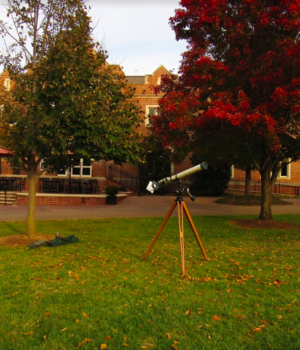Written by Bradley Bommarito
On Monday, Nov. 11, the planet Mercury traveled in front of the Sun, resulting in an astronomy event referred to as a “transit.” This resulted in a unique image that could be viewed on a telescope, in which Mercury appeared to be a tiny black dot moving over the Sun.
According to HowStuffWorks, transits of Mercury occur only about 13 times per century, always in May and November. Depending on your location on the planet, you may only have the opportunity to view a few of these. The next Mercury transit visible from North America will not occur until 2049.
RC’s Thomas Carter of the English and Communication Studies Department is an astronomy enthusiast who helped students and faculty catch a glimpse of this event from campus. With his 4-inch refractor telescope, he watched the first part of the transit starting at 7:15 a.m. behind Roselawn. He moved the telescope to the Back Quad at around 8 a.m. to encourage curious passerby to check out the transit.
“A fairly large number of people did stop by on their way to and from lunch, when the view was especially good. The transit ended just after 1 p.m. with the tiny planet slipping over the rim of the sun,” Carter said.
Carter has been seeking opportunities to view Mercury transits for many years now, hoping to be lucky enough to catch the event on a clear day. He notes that too many clouds prevented a successful viewing in 2006, the 2016 viewing was somewhat better, and last week’s transit gradually became clearer as the day went on and cloud cover dissipated. He feels grateful that he was able to watch the event one more time in his lifetime.
“As a visual event, transits aren’t dramatic– just a tiny black dot moving across the face of the sun. The excitement comes from the event’s infrequency coupled with thinking about what we’re seeing: one of the eight major planets outlined against the sun. It’s also a fun way to see this elusive planet. Because it’s so close to the sun, it never gets very high above the horizon and therefore is rarely noticed in the morning or evening sky,” said Carter.
If you missed last week’s transit, you’re out of luck for about 30 years. And if you’re holding out to catch the next transit of Venus, you have quite the wait ahead of you: the next one will not occur until Dec. 2117!




